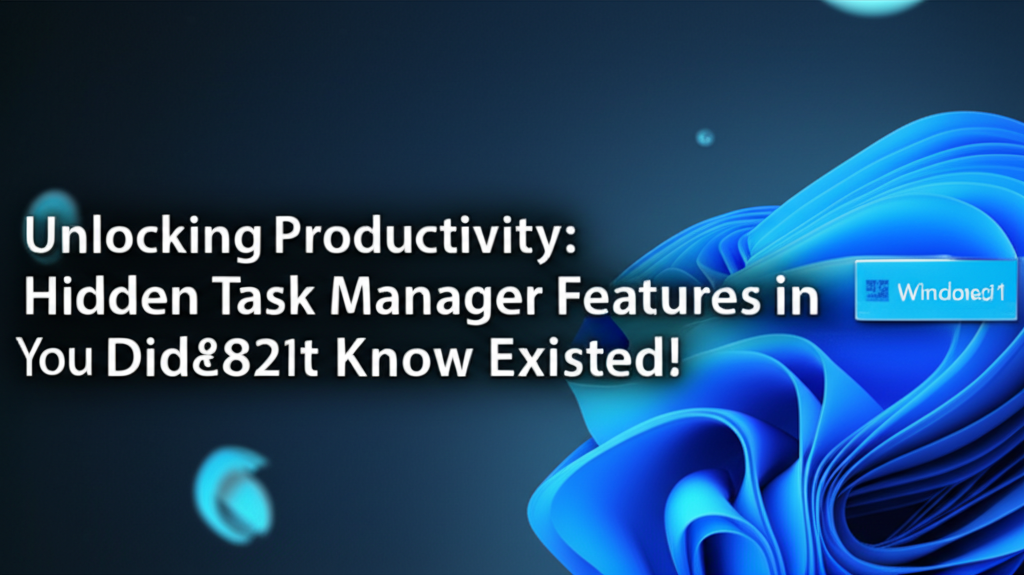Introduction
Windows 11 is packed with features designed to streamline productivity, yet many users remain unaware of the hidden gems within its Task Manager. Task Manager is not just a tool for killing unresponsive applications; it can be a powerful ally for managing your system resources, improving performance, and fine-tuning your daily tasks.
Understanding the intricacies of Task Manager can dramatically improve your workflow and enhance your overall computing experience. Whether you’re a student juggling multiple applications, a professional working from home, or a gamer looking to optimize performance, knowing these hidden features can give you a significant edge.
In this article, we will walk you through some commonly overlooked features of Task Manager, provide step-by-step instructions on how to use them, identify quick fixes for common issues, and offer advanced shortcuts for power users. Whether you’re a beginner or a seasoned tech enthusiast, there’s something here for everyone.
Step-by-Step: Unlocking Hidden Task Manager Features
1. Accessing Task Manager
The first step in utilizing the hidden features of Task Manager is knowing how to access it:
- Press Ctrl + Shift + Esc: This shortcut opens Task Manager directly.
- Right-click on the Taskbar: Select “Task Manager” from the context menu.
- Press Ctrl + Alt + Delete: Choose “Task Manager” from the options.
2. Understanding the Interface
Upon opening Task Manager, you will see a simplified interface with several tabs. Here’s a quick rundown of what each tab represents:
- Processes: Displays the currently running applications and background processes.
- Performance: Provides real-time data on CPU, Memory, Disk, and Network usage.
- Users: Shows all logged-in users and their resource utilization.
- Details: Offers detailed information about running processes.
- Services: Lists all Windows services and their statuses.
3. Managing Applications and Processes
3.1. End Task
If an application is unresponsive, you can force it to close:
- Go to the Processes tab.
- Right-click on the unresponsive application.
- Click End Task.
4. Monitoring Performance
4.1. Real-time Usage Stats
To track your system’s real-time performance:
- Go to the Performance tab.
- Click on CPU, Memory, Disk, or Network to see detailed statistics.
5. Starting Processes with Administrator Privileges
Running applications with administrative rights can resolve various issues:
- Navigate to the Details tab.
- Right-click on the application you wish to run as an administrator.
- Select Set Priority and choose Above Normal or High as needed.
6. Analyzing Startup Impact
Managing startup items can greatly enhance boot time:
- Click on the Startup tab.
- Review the list of applications.
- Right-click and select Disable on items you deem unnecessary at startup.
7. Energy Efficiency Insights
A newer feature in Windows 11 is the Energy Usage history:
- Open the Processes tab.
- Click on the Energy column to sort applications by energy consumption.
- Right-click on any application to see its Energy Usage and estimated impact on battery life.
8. Resource Monitor
Task Manager integrates with Resource Monitor for in-depth analysis:
- In the Performance tab, click on Open Resource Monitor at the bottom of the window.
- Use this tool to view detailed network activity, disk activity, and memory usage.
9. Setting Up Task Manager for Efficiency
9.1. Customize Columns
You can modify the columns displayed for better insight:
- In the Processes tab, right-click on the header.
- Choose Select Columns.
- Check or uncheck the columns you want to display.
10. Utilizing the App History
For users who want to analyze resource consumption over time, the App History feature is invaluable:
- Click on the App History tab.
- Review detail logs of CPU time, network usage, and Metered Network usage.
Alternative Software Recommendations
While Task Manager is powerful, other built-in Windows features may enhance functionality:
1. Windows Settings
- Settings > System > Storage: Monitor disk usage and free space.
2. Resource Monitor
More detailed insights compared to Task Manager for performance monitoring and troubleshooting.
3. Performance Monitor
Provides comprehensive data and customizable reports for advanced users.
Common Errors and Quick Fixes
Even with essential features, users may encounter some issues:
Error 1: Task Manager Fails to Open
Quick Fix:
- Check for Windows Updates and apply them.
- Restart your computer if the issue persists.
Error 2: Application Not Responding
Quick Fix:
- Use Task Manager to end the task as mentioned in Step 3.1.
- Check for software updates for the unresponsive application.
Error 3: Performance Lag
Quick Fix:
- Monitor CPU and Memory usage through the Performance tab and identify resource-heavy applications.
Advanced Tweaks and Shortcuts for Power Users
1. Keyboard Shortcuts
Mastering keyboard shortcuts can greatly improve efficiency:
- Ctrl + Shift + Esc: Opens Task Manager instantly.
- Alt + E: Ends the selected process.
2. Customizing Task Manager Behavior
You can also enable "Always on Top":
- Open Task Manager.
- Click on Options in the top menu.
- Select Always on Top.
3. Creating Task Manager Shortcuts
For quick access, create a shortcut on your desktop:
- Right-click on your Desktop.
- Select New > Shortcut.
- Enter taskmgr.exe and click Next.
- Name your shortcut and click Finish.
Summary Checklist: Quick Reference
Here’s a quick checklist you can refer to when using Task Manager:
- Accessing: Use Ctrl + Shift + Esc or right-click on Taskbar.
- Processes: End unresponsive tasks or monitor current applications.
- Performance: Check real-time stats and open Resource Monitor.
- Startup: Disable unnecessary applications for faster boot times.
- Energy Management: Monitor energy usage and make adjustments.
Conclusion
By tapping into the hidden features of Windows 11’s Task Manager, you’re not just managing tasks; you’re optimizing your entire computing experience. Whether it’s managing startup applications, monitoring resource utilization, or running applications with elevated privileges, understanding these tools enables you to maximize productivity.
As you become more familiar with these features, you’ll likely find additional tweaks and shortcuts that suit your specific workflows. With Task Manager, Windows 11 is more than just an operating system; it’s a powerhouse of productivity that can work for you. Happy task managing!

